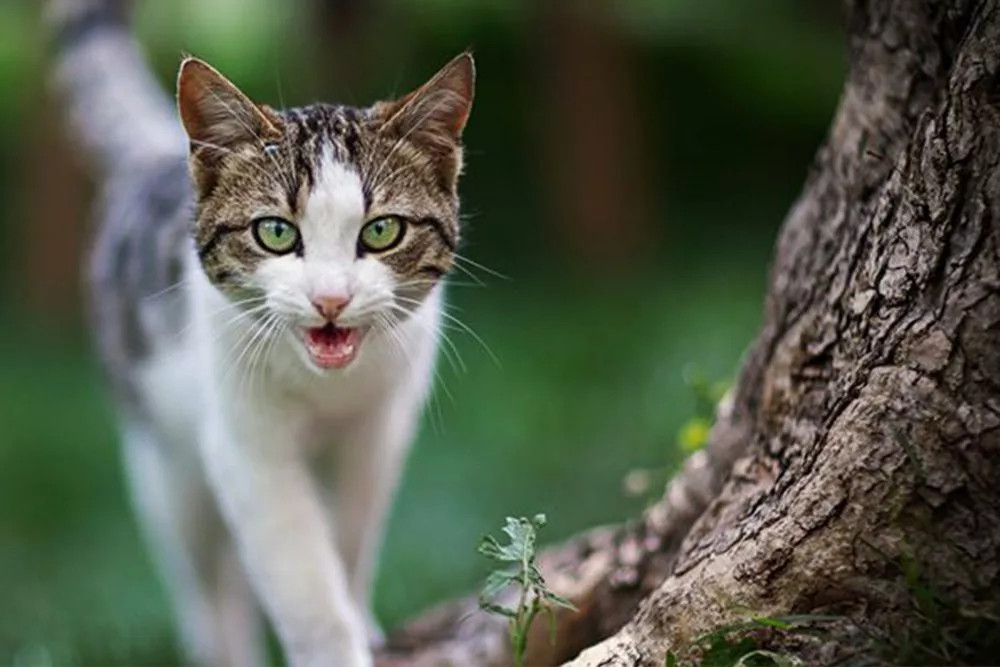Cats meow – it’s one of the most familiar sounds of cat ownership. But have you ever stopped to wonder, “Why Does My Cat Keep Meowing?” While a gentle meow can be a sweet greeting, persistent or excessive meowing can leave cat owners puzzled and sometimes concerned. Unlike dogs who bark to communicate with each other, cats primarily meow to communicate with humans. This unique vocalization is their way of telling us something, and understanding the reasons behind it is key to a happy and healthy relationship with your feline companion.
Just like humans use different tones and volumes to express themselves, cats have a variety of meows, each potentially carrying a different message. From a soft chirp to a loud yowl, deciphering these sounds can feel like learning a new language. If your cat’s meowing has become more frequent or persistent, it’s natural to want to understand why. This article will explore the common reasons behind excessive cat meowing, helping you decode your cat’s vocalizations and address their needs effectively.
 A ginger cat meowing while looking directly at the viewer, conveying a sense of communication and need.
A ginger cat meowing while looking directly at the viewer, conveying a sense of communication and need.
Common Reasons for Excessive Cat Meowing
There are many reasons why your cat might be meowing more than usual. Understanding the context of the meowing, along with your cat’s body language and routine, can help you pinpoint the cause. Here are some of the most common reasons behind persistent feline vocalization:
Seeking Attention and Interaction
Cats are social creatures who thrive on interaction with their human families. One of the primary reasons for meowing is simply to get your attention. Your cat may be seeking playtime, petting, or even just your presence. If you’ve been busy or away from home, your cat might meow to initiate interaction and remind you that they are there and ready for some love.
What to do: Make time for daily interaction with your cat. Engage in playtime with toys, offer gentle petting and grooming, and simply spend quality time in their company. Ignoring attention-seeking meows can sometimes inadvertently reinforce the behavior, as your cat may escalate their vocalizations to get a response. Instead, acknowledge their meow and then initiate interaction on your terms, rewarding quieter behavior.
Expressing Fear or Anxiety
Meowing can also be a sign of fear, stress, or anxiety. Loud noises like thunderstorms or fireworks, unfamiliar visitors, or changes in their environment can trigger anxious meowing. Cats are creatures of habit and can become stressed by disruptions to their routine or territory.
What to do: Identify potential stressors in your cat’s environment. Provide a safe and secure space where they can retreat when feeling anxious, such as a quiet room, a cozy bed, or a high perch. Minimize exposure to loud noises or sudden changes whenever possible. If your cat’s anxiety is severe or persistent, consult with your veterinarian about potential solutions, such as calming aids or behavioral therapy.
Mating Behavior (Especially in Unspayed/Unneutered Cats)
If your cat is not spayed or neutered, excessive meowing, especially at night, could be related to mating behavior. Female cats in heat will often yowl loudly and persistently to attract male cats. Unneutered male cats may also meow excessively in response to the calls of females or out of territoriality.
What to do: Spaying or neutering your cat is the most effective way to eliminate meowing related to mating behavior. This procedure not only reduces unwanted vocalization but also offers numerous health and behavioral benefits for your cat. Consult with your veterinarian about the appropriate age and procedure for spaying or neutering your cat.
Hunger and Food Seeking
Cats are masters of associating meowing with positive outcomes, and food is a powerful motivator. If your cat has learned that meowing gets them fed, they may vocalize whenever they are hungry or anticipate mealtime. This can become particularly persistent if they are accustomed to being fed on demand or receiving frequent treats.
What to do: Establish a consistent feeding schedule for your cat and stick to it. Avoid feeding your cat immediately when they meow, as this reinforces the connection between vocalization and food. Instead, wait for a quiet moment before preparing their meal. If your cat begs for food between meals, try distracting them with playtime or attention rather than giving in to their demands.
Underlying Medical Issues
Sometimes, excessive meowing can be a sign of an underlying medical problem. Various health conditions can cause increased thirst, hunger, pain, or disorientation, leading to changes in vocalization. For example, hyperthyroidism can increase appetite and activity levels, potentially resulting in more frequent meowing for food. Cognitive dysfunction in older cats can also lead to confusion and increased vocalization, especially at night.
What to do: If your cat’s meowing is sudden, excessive, or accompanied by other symptoms like changes in appetite, water intake, litter box habits, or activity level, it’s crucial to consult with your veterinarian. A thorough veterinary examination can help rule out or diagnose any underlying medical conditions and ensure your cat receives appropriate treatment.
Age-Related Cognitive Decline
As cats age, they can experience cognitive decline, similar to dementia in humans. Feline cognitive dysfunction syndrome (CDS) can cause disorientation, confusion, and changes in behavior, including increased meowing. Older cats with CDS may meow more frequently, especially at night, due to confusion or feeling lost, even in familiar surroundings.
What to do: If you suspect your senior cat’s meowing might be related to cognitive decline, discuss your concerns with your veterinarian. While there is no cure for CDS, there are management strategies that can help improve your cat’s comfort and quality of life. These may include environmental modifications like nightlights, easily accessible resources, and medications or supplements to support brain health.
Greeting and Social Interaction
Not all meowing is a cause for concern. Many cats meow as a way of greeting their owners when they come home or enter a room. This type of meowing is often accompanied by other friendly behaviors like rubbing against legs, purring, and tail up. It’s a sign that your cat is happy to see you and is engaging in social interaction.
What to do: Enjoy these welcoming meows! Respond to your cat’s greetings with affection and attention. This positive reinforcement strengthens your bond and encourages healthy communication.
Decoding Different Types of Meows
Paying attention to the nuances of your cat’s meows can provide further clues about what they are trying to communicate. While it takes time and observation to become fluent in “cat speak,” here’s a general guide to different meow sounds:
- Short, high-pitched meow: Often a friendly greeting, like “hello!”
- Mid-pitched meow, repeated: Could be a plea for attention, food, or petting.
- Low-pitched meow, drawn out (moaning sound): May indicate displeasure, frustration, or pain.
- Loud, insistent meow or yowl: Can signal urgency, distress, anger, or territoriality.
- Chirps or trills: Often used to express excitement or to get your attention, sometimes seen when they spot prey.
What to Do When Your Cat Won’t Stop Meowing
If your cat’s excessive meowing is becoming disruptive or concerning, here are some strategies to address the issue:
- Rule out medical causes: Schedule a veterinary check-up to ensure there are no underlying health problems contributing to the meowing.
- Identify the trigger: Pay close attention to when and where the meowing occurs. What was happening just before your cat started meowing? Identifying triggers can help you address the root cause.
- Provide attention on your terms: If your cat is attention-seeking, acknowledge their meow but don’t immediately give in to their demands. Wait for a quiet moment and then initiate interaction.
- Ignore attention-seeking meows (sometimes): In some cases, especially with food-related meowing, ignoring the vocalization can be effective in reducing the behavior over time. Be consistent and patient.
- Enrich their environment: Provide plenty of toys, scratching posts, climbing structures, and opportunities for play and exploration to keep your cat mentally and physically stimulated. A bored cat is more likely to seek attention through meowing.
- Consider calming aids: If anxiety is a factor, explore calming aids like pheromone diffusers, calming supplements, or anxiety-reducing medications under veterinary guidance.
- Never punish meowing: Punishment is ineffective and can damage your relationship with your cat. Focus on understanding the cause of the meowing and addressing it positively.
We Can Help with Your Cat’s Vocalizations
Understanding why your cat keeps meowing is the first step in addressing the behavior and ensuring their well-being. By paying attention to the context, type of meow, and your cat’s overall health and behavior, you can become more attuned to their needs and strengthen your bond. If you are concerned about your cat’s excessive meowing, don’t hesitate to reach out to your veterinarian for guidance and support. They can help rule out medical issues, offer behavioral advice, and ensure your feline friend is happy and healthy. For any questions or concerns about your cat’s behavior, please contact your veterinarian.

